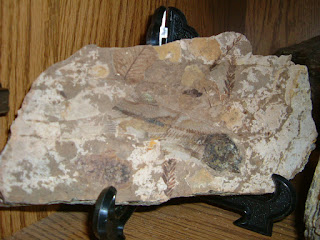The graptolite faunas of the upper member of the Anse au Crapaud Formation include the Arienigraptus gracilis, Oncograptus upsilon, Undulograptus austrodentatus, and Holmograptus spinosus biozone faunas and, thus, complement the well known Darriwilian faunas of the Cow Head, Table Head, and Goose Tickle groups of western Newfoundland. In particular, the Holmograptus spinosus Biozone interval of calcarenitic limestones bears a rare combination of benthic (shelly) and planktic (graptolitic) faunas with conodonts, brachiopods, ostracods, sponge spicules, and algal remains associated with common graptolites that allow an inter-continental correlation.
The Holmograptus spinosus Biozone is introduced for the interval based on a diverse and characteristic graptolite fauna. The fauna includes among others, Atopograptus woodwardi, recognized for the first time in North America. The Holmograptus spinosus Biozone fauna can be found worldwide and is easily correlated into the conodont biofacies using species of the genus Histiodella. He looked at ties between graptolite and conodont biozonations for the Darriwilian. Some lovely silicified ostracods were illustrated for the first time from the interval and a new species, Hustedograptus quebecensis, was introduced.
The Darriwilian or late Middle Ordovician time interval shows a dramatic re-organization of graptolite faunas, both in their taxonomic composition and in their rhabdosome developmental style.
The Early Ordovician graptolite faunas, composed of multiramous to pauciramous “Dichograptaceans” (Bulman 1970), are slowly replaced by dipleural biserial graptolites of the “Diplograptaceans” (Mitchell et al. 1995, 2007) or Axonophorans (Maletz et al. 2009).
This shift started with the introduction of the reclined isograptids and glossograptids in the Dapingian and culminated with the extinction of multiramous sinograptids and stem reclinatids in the Darriwilian (Da 2 – Da 3), leaving but few survivors to reach the Late Ordovician. The monopleural glossograptids, as a second clade of the Bireclinata, enjoyed moderate success in the mid and Late Ordovician, but never attained the high diversity of the Axonophorans.
The Darling Darriwilian
The Darriwilian is a significant stage in the Middle Ordovician. It is here we see the first land plants and the introduction of the Undulograptus austrodentatus graptolite zone. These graptolite outcrops from around the world help us establish the base of the Darriwilian as an easily correlatable marker in time. Yet, for so many reasons, the charming Darriwilian has not received the attention in graptolite studies it deserves and little is known about many of the graptolites from the interval.
The biostratigraphy within this time interval remains only partially explored due to a scarcity of uninterrupted successions. The Darriwilian in Victoria, Australia (Vandenberg and Cooper 1992) is based on numerous spot collections, but successions spanning more than a single graptolite zone are not available. The base of the Darriwilian is now defined at the first appearance datum (FAD) of Undulograptus austrodentatus in the Huangnitang section (Zhejiang, China), but the graptolitic succession is less detailed and complete in the higher part of the interval (see Chen et al. 2006).
The northern Appalachian successions in Quebec and western Newfoundland provide numerous successions from which detailed biostratigraphical data are available, but most sections are poorly studied. Recent advances show the presence of good Darriwilian graptolite faunas in the Cow Head, Table Head, and Goose Tickle groups of western Newfoundland (Williams and Stevens 1988; Maletz 1992c; Taylor 1997) and China (Chen et al. 2006) that provide a better insight into the biostratigraphy and evolutionary history of graptolites in this interval.
Lithostratigraphic Succession at Les Méchins
The southern shore of the St. Lawrence River along the coast of the Gaspé Peninsula of Quebec exposes Cambrian to Ordovician continental slope sequences, representing the allochthonous thrust slices of the Humber tectonostratigraphic zone of Williams (1979). The successions were thrust westwards across the eastern rim of Laurentia during the Taconic Orogeny in the Middle Ordovician. Because of the complexity of the successions, the stratigraphy is only well defined in part and detailed biostratigraphic work is lacking for most regions.
Bernstein et al. (1992) described the lithostratigraphic succession at Les Méchins and provided detailed information on the location of the sections along the northern side of route 132, directly west of the entrance to Les Méchins.
As graptolites are the most important biostratigraphic indicators, their record can shed light on the structural complexity of the successions and help us to understand the geological evolution of this region. Newly discovered faunal successions at Les Méchins, Quebec have provided important biostratigraphical and biogeographical data and yielded taxa not previously found in North America.
Maletz, Jörg. Holmograptus spinosus and the Middle Ordovician (Darriwilian) graptolite biostratigraphy at Les Méchins (Quebec, Canada) Canadian Journal of Earth Sciences, 2009, 46:739-755, https://doi.org/10.1139/E09-048.
Albanesi, G., Hünicken, M.A., and Barnes, C.R. 1998. Bioestratigrafia de conodontes de las secuencias ordovicicas del Cerro Potrerillo, Precordillera central de San Juan, R. Argentina. Actas XII Academia Nacional de Ciencias., Córdoba, 12, pp. 7–72.
Bulman, O.M.B. 1970. Graptolithina with sections on Enteropneusta and Pterobranchia. In Treatise on invertebrate paleontology, Part V. 2nd ed. Edited by K. Teichert and R.C. Moore. Geological Society of America and University of Kansas Press, Boulder, Colo. and Lawrence, Kans., pp. 1–163.
Chen X, Zhang YD, Bergström SM, Xu H-G. 2006. Darriwilian graptolite and conodont zonation in the global stratotype section of the Darriwilian stage (Ordovician) at Huangnitang, Changshan, Zhejiang, China. Palaeoworld 15(2): 150-170.





































